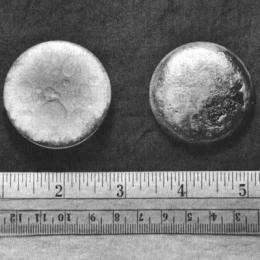May 18, 2012 report
After 50 year search, research team finds plutonium signature

(Phys.org) -- After fifty years of trying by various researchers, a group made up of teams from Los Alamos National Libratory in the US and the Atomic Energy Agency in Japan, have succeeded in spotting the signature of plutonium-239 with magnetic resonance (NMR) spectroscopy. Using a super cooled sample of plutonium(IV) oxide, the team as they describe in their paper published in the journal Science, was able to stabilize magnetic interference to find the elusive signature.
NMR spectroscopy has been used for years to analyze and hopefully gain a better understanding of many materials; of particular interest have been those that have a quantum spin of ½, such as hydrogen and carbon isotopes. One that has been a stickler however, is plutonium-239, which until now has defied attempts by researchers to observe its signature due to its unusually powerful internal magnetic field that results from the strong interaction between two of its electrons with its nucleus. Also complicating matters are restrictions placed on researchers trying to analyze it due to both political and safety issues.
Now however, circumstances came together in just the right way to allow the combined team to get a glimpse of what so many before them had been looking for. To make it happen, they cooled a sample of plutonium(IV) oxide to 4 Kelvin, which allowed them to side-step the problem of magnetic field issues while at the same time slowing things down giving the researchers time to see what was happening with the sample during spectroscopy. After fifty years of futility, that was apparently all it took.
They key the team says, was in choosing the right material. Their plutonium(IV) oxide dust sample was not only 94% pure, but available. They also pointed out that the team had more time to focus on their project than had others before, which meant they could make many runs, each time tweaking the parameters slightly as they searched for the signal, which was eventually found at near 5.8 Tesla. They also note that they were in fact about to give up entirely just prior to finding success.
In addition to offering important new information about plutonium-239, observation of its signature, i.e. nailing down its spectrum, is expected to help researchers find better ways to deal with nuclear waste.
More information: Observation of 239Pu Nuclear Magnetic Resonance, Science 18 May 2012: Vol. 336 no. 6083 pp. 901-904 DOI: 10.1126/science.1220801
ABSTRACT
In principle, the spin-½ plutonium-239 (239Pu) nucleus should be active in nuclear magnetic resonance spectroscopy. However, its signal has eluded detection for the past 50 years. Here, we report observation of a 239Pu resonance from a solid sample of plutonium dioxide (PuO2) subjected to a wide scan of external magnetic field values (3 to 8 tesla) at a temperature of 4 kelvin. By mapping the external field dependence of the measured resonance frequency, we determined the nuclear gyromagnetic ratio 239γn(PuO2)/2π to be 2.856 ± 0.001 megahertz per tesla (MHz/T). Assuming a free-ion value for the Pu4+ hyperfine coupling constant, we estimated a bare 239γn/2π value of ~2.29 MHz/T, corresponding to a nuclear magnetic moment of μn ≈ 0.15μN (where μN is the nuclear magneton).
Journal information: Science
© 2012 Phys.Org
















